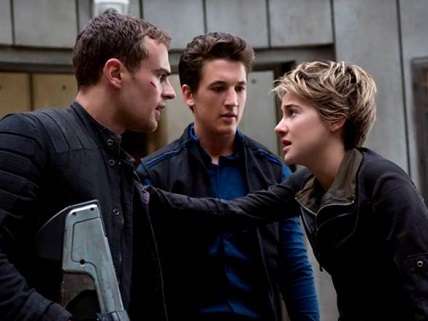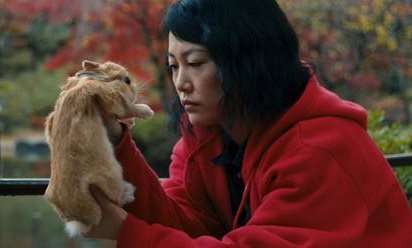Movie Reviews: Insurgent and Kumiko Fail to Impress
Shailene Woodley in a sub-par sequel and Rinko Kikuchi in an overhyped Sundance item.


Those who love Veronica Roth's bestselling books may be distressed to learn that Insurgent, the sequel to last year's dystopian megaplex hit Divergent, takes major liberties with the Roth novel on which it's based. Or so I'm told by a colleague long conversant with the author's young-adult Divergent trilogy. I won't detail the changes my informant lists, but will note that a mysterious box has been inserted into the story that fans won't remember from the novel, because it's not there. Some readers may be annoyed by such jarring cinematic adjustments, but as I suppose the filmmakers might respond, so what?
Surprisingly, for a sequel to a movie that grossed more than a quarter-billion dollars worldwide, a new creative crew has been brought in here—new director, writers, cinematographer, production designer, composer. The result is a movie that suffers not only from the usual stuck-in-the-middle problems of the second installment of many trilogies (think The Matrix Reloaded, not The Empire Strikes Back), but also from a lack of the plot clarity and kinetic thrust that kept the first picture from being a pure Hunger Games knockoff. The narrative is muddled here, and there are scenes of achingly dull discourse. Worse yet, the movie fritters away its most potent asset, Shailene Woodley, returning as the scrappy teen rebel Tris.
Once again we are in post-apocalyptic Chicago, 200 years after a war of some sort reduced the city to a rubbly metropolis ringed around by a towering wall. (In the last movie—just five days ago in the story's chronology—the war was 100 years in the past.) You'll recall that the citizens inside the wall all know their place, because they've each been assigned to one of five groups. The members of Abnegation are selfless, those in Candor are honest, the Dauntless are brave, the Erudite are brainy, and the folks in Amity are peace-loving hippies. Tris is different. She's Divergent, incorporating traits of more than one faction, and is thus considered an enemy of the ordered society currently overseen by Erudite leader Jeanine (frosty Kate Winslet). At the end of the previous film, Tris and a band of friends fled the city for their lives. Remember?
Okay. Now, as Insurgent begins, we find Tris and her fellow refugees—including hunky boyfriend Four (Theo James), ambiguous brother Caleb (Ansel Elgort), and freelance weisenheimer Peter (Miles Teller)—being rousted from among the goats and gardens of a rural Amity settlement where kindly leader Johanna (Octavia Spencer) has given them shelter. Fleeing Jeanine's storm troopers, the kids hop a train bound for the city, where they end up at the underground headquarters of the Factionless, a disgruntled community overseen by Four's long-lost mother Evelyn (Naomi Watts), who's plotting to depose Jeanine and seize the reins of power herself.
Jeanine of course has her own plans. She believes the aforementioned mysterious box will help consolidate her rule. Unfortunately, it can only be opened by a Divergent—in fact, by the most powerful of all Divergents. "The One," you might say. Whom that might be is a question that will occur to no one.
We know this story is going to leave us hanging, and there's not much director Robert Schwentke can do about that. Some of the actors on hand seem, like us, to be marking time. The movie could have used a little more of Miles Teller's virtuoso sarcasm and Naomi Watts' oblique menace. And it's disappointing to see Woodley so fenced in by the truncated plot. Her Tris is a hero who hasn't fully come into her heroism, and she spends a lot of the movie in woebegone reverie. The effects in this movie are oddly conceived (people and objects sometimes flake away into what could be clouds of CGI dandruff), but Woodley has one memorable action scene, racing around on the outside of a burning house as it tumbles through the air; and her face-off against a dark replica of herself is a reminder of her technical skill. But she's too good for such middling material.
The movie holds forth a promise that the story will liven up in its final installment, Allegiant—which, in the usual profit-maximizing franchise manner, will be split into two parts for parceling out over the next two years. Could be interesting, I suppose. To get to that wrapup, though, you'll first have to get through this.

Kumiko: The Treasure Hunter
Some art movies are so subtle you have to work to get what's going on in them, and afterward you're glad you did. Others (Jim Jarmusch's The Limits of Control and Nicolas Winding Refn's Only God Forgives leap to mind) turn out to be bogus—there's nothing to get. David Zellner's Kumiko: The Treasure Hunter, a vaporous Sundance hit, is one of those.
The movie is constructed around the Coen brothers' 1996 film Fargo. It begins in Japan, with a woman walking along a beach. She's holding a map that leads her to a small cave. Stepping inside, she finds a rock, lifts it up, and withdraws a waterlogged VHS tape. Returning to her cramped apartment, she slips the tape into a VCR machine and begins playing it with no problem. (This is the second of the movie's several curiosities; the first is where the map that led her to the tape came from.)
The woman's name is Kumiko (Rinko Kikuchi), and the movie she begins watching is Fargo. She's fixated on one scene—the part where Steve Buscemi buries a briefcase filled with nearly a million dollars alongside a wire fence in a vast snowfield. Playing this scene over and over, she takes notes on it, and uses a tape measure to calculate distances on the screen. She fashions a needlepoint map. She shares a cup of noodles with her pet rabbit. The rabbit's name is Bunzo.
Kumiko is a glum, bedraggled Tokyo office drone, disdained by her coworkers and disliked by her boss. She speaks virtually no English, but one day, after abandoning Bunzo, she boards a flight to Minneapolis. Upon arrival she gets on a bus, and is soon underway to Fargo, North Dakota, where she intends to locate Buscemi's cash-packed briefcase. Apparently she neglected to watch more than that one scene in the Coens' movie; had she done so, she would know that Buscemi actually buried his treasure in Minnesota.
Many things begin to frustrate Kumiko's desire to reach Fargo, few of them gripping. (This is a road movie that's mostly road.) A number of quirky characters crop up—a helpful old lady, a sympathetic cop (played by director Zellner). The landscape through which Kumiko passes is bleak and snowy. At one point, checked into a roadside motel, she cuts up a quilt and dons it for warmth. This puffy garment suggests a Japanese ceremonial robe, possibly a traditional wedding dress. If that resemblance was intended, the purpose, like so much else in this film, is unclear. The movie ends with a fairytale flourish, which you will be forgiven for finding ridiculous.
Rinko Kikuchi, who was nominated for an Oscar for her supporting performance in the 2006 Babel, used a character's minimal knowledge of English for tart comic effect in Rian Johnson's undervalued 2008 film, The Brothers Bloom. Here, though, confined by a script written by Zellner and his brother, Nathan, she's unable to project anything beyond mute dejection. Kumiko doesn't seem like a woman following her dream; she's clearly mentally ill. This in turn recalls Roman Polanski's Repulsion, which also featured a near-catatonic female protagonist, and a rabbit as well. (Although the more-fortunate Bunzo doesn't wind up rotting on a plate.) But Polanski's film was a horror story. This isn't, and Kumiko's dark nature sits awkwardly amid these more lighthearted goings-on. We're meant to care about this sullen woman, but after nearly two hours it's still not clear why we should.


Show Comments (15)